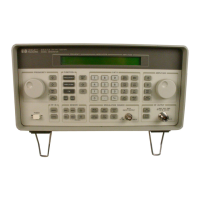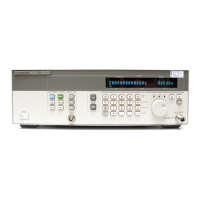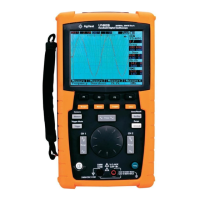18-45
Measure Commands
TMIN
Example 10 OUTPUT 707;”:SYSTEM:HEADER OFF”
20 OUTPUT 707;”:MEASURE:TMAX?”
TMIN
Command :MEASure:TMIN [<source>]
Measures the first time at which the first minimum voltage of the source waveform occurred.
The source is specified with the MEASure:SOURce command or with the optional parameter
following the TMIN command. In TDR mode, the time reported is measured with respect to
the reference plane. <source> is {CHANnel<N> | FUNCtion<N> | WMEMory<N> |
RESPonse<N>}. <N> is an integer, from 1 through 4.
Mode Oscilloscope and TDR modes.
Query :MEASure:TMIN? [<source>]
The query returns the time at which the first minimum voltage occurred.
Returned Format [:MEASure:TMIN] <time>[,<result_state>]<NL>
<time> is the time at which the first minimum voltage occurred. If SENDvalid is ON, the
<result_state> is returned with the measurement result. Refer to Table 18-4 on page 18-39
for a list of the result states. When receiving numeric data into numeric variables, turn off the
headers. Otherwise, the headers may cause misinterpretation of returned data.
Example 10 OUTPUT 707;”:SYSTEM:HEADER OFF”
20 OUTPUT 707;”:MEASURE:TMIN?”
TVOLt?
Query :MEASure:TVOLt? <voltage>,<slope><occurrence>[,<source>]
Returns the time interval between the trigger event and the specified voltage level and transi-
tion (oscilloscope mode) or the time interval between the reference plane and the specified
voltage level and transition (TDR mode). The source is specified with the MEASure:SOURce
command or with the optional parameter following the TVOLt? query. <voltage> is the volt-
age level at which time will be measured. <slope> is the direction of the waveform change
when the specified voltage is crossed, rising (+) or falling (–). <occurrence> is the number of
the crossing to be reported. If one, the first crossing is reported; if two, the second crossing is
reported, and so on. <source> represents {CHANnel<N> | FUNCtion<N> | WMEMory<N> |
RESPonse<N>} where <N> is an integer, from 1 through 4.
Mode Oscilloscope and TDR modes.
Returned Format [:MEASure:TVOLt] <time>[,<result_state>]<NL>
<time> is the time interval between the trigger event (or reference plane, in TDR mode) and
the specified voltage level and transition. If SENDvalid is ON, the <result_state> is returned
with the measurement result. Refer to Table 18-4 on page 18-39 for a list of the result states.
When receiving numeric data into numeric variables, turn off the headers. Otherwise, the
headers may cause misinterpretation of returned data.
Example The following example returns the time interval between the trigger event and the transition
through –.250 Volts on the third rising edge of the source waveform to the numeric variable,
Time.
